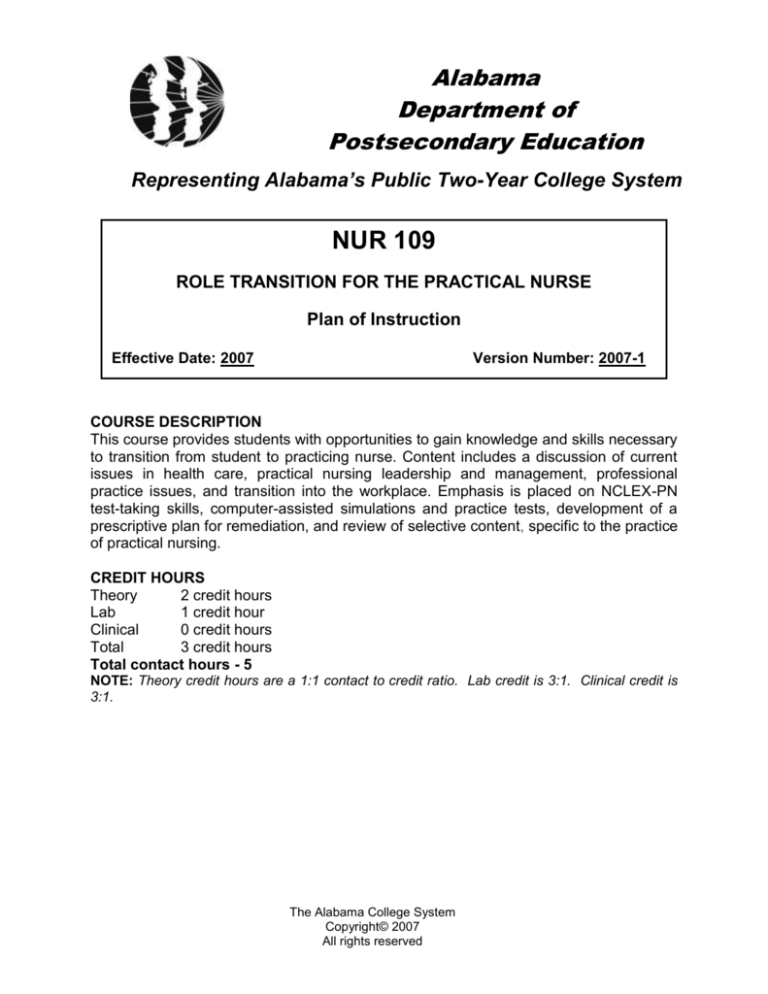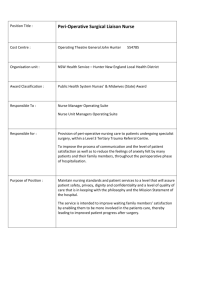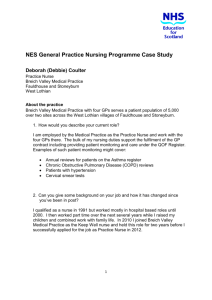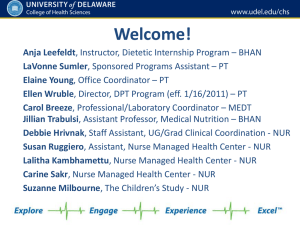
Alabama
Department of
Postsecondary Education
Representing Alabama’s Public Two-Year College System
NUR 109
ROLE TRANSITION FOR THE PRACTICAL NURSE
Plan of Instruction
Effective Date: 2007
Version Number: 2007-1
COURSE DESCRIPTION
This course provides students with opportunities to gain knowledge and skills necessary
to transition from student to practicing nurse. Content includes a discussion of current
issues in health care, practical nursing leadership and management, professional
practice issues, and transition into the workplace. Emphasis is placed on NCLEX-PN
test-taking skills, computer-assisted simulations and practice tests, development of a
prescriptive plan for remediation, and review of selective content, specific to the practice
of practical nursing.
CREDIT HOURS
Theory
2 credit hours
Lab
1 credit hour
Clinical
0 credit hours
Total
3 credit hours
Total contact hours - 5
NOTE: Theory credit hours are a 1:1 contact to credit ratio. Lab credit is 3:1. Clinical credit is
3:1.
The Alabama College System
Copyright© 2007
All rights reserved
Role Transition for the Practical Nurse
NUR 109
PREREQUISITE COURSES
NUR 105 – Adult Nursing
NUR 106 – Maternal and Child Nursing
ENG 101 – English Composition I
BIO 202 – Anatomy and Physiology II (If student selected BIO 201)
CO-REQUISITE COURSES
NUR 108 – Psychosocial Nursing
NUR 107 – Adult/Child Nursing
INSTRUCTIONAL NOTE: Content for Module G, NCLEX-PN Preparation, (45 hours)
should be presented concurrently with other modules.
INSTRUCTIONAL GOALS
Cognitive - Comprehend foundational knowledge of the process of transitioning from
student to practicing nurse.
Performance - Apply foundational knowledge when transitioning from student to
practicing nurse.
PROFESSIONAL COMPETENCIES/OBJECTIVES
Unless otherwise indicated, evaluation of student’s attainment of cognitive and
performance objectives is based on knowledge and skills gained from this course.
Competencies specified for each module may be set by certification agencies, national
and state codes, health care facility policies, locally developed lab/clinical assignments,
or any combination. Students are expected to utilize relevant technology for client care
and documentation.
PROFESSIONAL COMPETENCIES
Explain current issues in health care
Demonstrate leadership and management skills.
Incorporate professional practices into managing client care.
Explain state board of nursing and licensure eligibility requirements.
Prepare for transition to the workplace
Prepare for the NCLEX-PN
ACS Copyright© 2007
All rights reserved
2
Role Transition for the Practical Nurse
NUR 109
MODULE A – CURRENT ISSUES IN HEALTH CARE
PROFESSIONAL COMPETENCIES
A1.0 Explain current issues in health
care. (C)
A1.1
PERFORMANCE OBJECTIVES
This module is measured cognitively.
LEARNING OBJECTIVES
A1.1.1
Differentiate between primary, secondary, and tertiary health care
services.
A1.1.2 Explain factors that influence health care.
A1.1.3 Explain services provided in selected health care settings.
A1.1.4 Explain the role of the licensed practical nurse in selected health care
settings.
A1.1.5 Predict the effect of staffing patterns, full time equivalent, acuity, and
patient classification systems on the quality of health care.
A1.1.6 Describe the differences among financial programs for health care
service reimbursement.
A1.1.7 Explain the role of the licensed practical nurse in quality improvement
and quality assurance.
A1.1.8 State the importance of resource management.
A1.1.9 Explain the response of the licensed practical nurse to current
challenges in health care.
A1.1.10 Explain the impact of emerging technologies in health care.
LAB SKILLS
None
ACS Copyright© 2007
All rights reserved
KSA
Indicators
C
B
c
c
d
B
c
B
d
C
3
Role Transition for the Practical Nurse
NUR 109
MODULE A OUTLINE
Health care delivery systems
Types of health care services
o Primary
o Secondary
o Tertiary
Factors influencing health care
o Accessibility
o Cost
o Quality of services
Health Care Settings
o Ambulatory services
o Inpatient care
o Home health
o Long-term care
o Day programs
o Assisted living
o Hospice
o Schools
o Industrial clinics
o Community nursing centers
o Voluntary health care agencies
o Rural primary care hospitals
Trends and economics in the health care delivery system
Role of the licensed practical nurse
Staffing, FTE, acuity, patient classification systems
Managed care
o Preferred Provider Organizations (PPO)
o Health Maintenance Organizations (HMO)
o Exclusive Provider Organizations (EPO)
Government Sponsored Insurance Plan
o Medicare – Medicaid
o Diagnostic Related Groups (DRG)
o Military Health Care (Tri-care/CHAMPUS)
o Children’s Health Insurance Program
o Centers for Medicare and Medicaid (CMS)
Private Pay/Non-insured
Private Insurance
Independent practice
Quality improvement/quality assurance
o Cost-effective practices
o Quality assurance practices
o Quality improvement practices
o Critical pathways, care maps, nursing care plans
ACS Copyright© 2007
All rights reserved
4
Role Transition for the Practical Nurse
NUR 109
MODULE A OUTLINE (Continued)
Resource management
Challenges for healthcare providers within the health care system
Disillusionment with providers
Loss of control
Decreased hospital use
Changing practice settings
Ethical issues
Vulnerable populations
Nursing’s response to health care challenges
Agenda for health care reform
Standards of care
Advanced practice
Nursing informatics
Computerized documentation
Access to information
Privacy protection
ACS Copyright© 2007
All rights reserved
5
Role Transition for the Practical Nurse
NUR 109
MODULE B – PRACTICAL NURSING LEADERSHIP AND MANAGEMENT
PROFESSIONAL COMPETENCIES
PERFORMANCE OBJECTIVES
B1.0 Demonstrate leadership and
management skills. (2c)
B1.1 Given scenarios use leadership and management
skills to resolve selected issues in health care.
KSA
LEARNING OBJECTIVES
Indicators
B1.1.1 Contrast the roles of registered nurse, practical nurse, and unlicensed
d
assistive personnel.
B1.1.2 Differentiate between leadership and management.
C
B1.1.3 Identify leadership styles.
c
B1.1.4 Identify leadership skills.
c
B1.1.5 Explain the roles and responsibilities of members of a team.
c
B1.1.6 Explain the role of the licensed practical nurse related to professional and
d
collaborative communication within the health care team.
B1.1.7 Explain the relationship between decision making and problem solving.
C
B1.1.8 Outline the skills needed for effective management.
c
B1.1.9 Explain prioritizing client care.
d
B1.1.10 Differentiate between assignment and delegation.
C
B1.1.11 Explain the rights of delegation.
C
B1.1.12 Explain the legal aspects of delegation according to Boards of Nursing.
C
B1.1.13 Explain time management.
b
B1.1.14 Explain conflict management.
b
B1.1.15 Explain stress management techniques.
b
B1.1.16 Explain the role of the licensed practical nurse in client advocacy.
c
LAB SKILLS
Critical thinking skills
Leadership/management skills
Conflict resolution
Professional/collaborative communication
Time management
Delegation/assignment
Team membership
Stress management
ACS Copyright© 2007
All rights reserved
6
Role Transition for the Practical Nurse
NUR 109
MODULE B OUTLINE
Differentiation of practice
RN
LPN
Unlicensed Assistive Personnel
Leadership vs. management
Leadership styles
Leadership skills
Team building
Team membership
Roles
Group dynamics
Professional – collaborative communication
Decision making and problem solving
Management skills
Planning
Organizing
Supervising
Monitoring
Prioritizing care
Delegation vs. assignment
Boards of Nursing
o Administrative Code
http://www.abn.state.al.us
Chapter 610-X-2
o Nurse Practice Act
Rights of delegation
Time Management
Conflict Management
Conflict resolution strategies
Negotiation strategies
Institutional policies
Contractual and informal agreements
Collective bargaining
Stress Management
Client Advocacy
ACS Copyright© 2007
All rights reserved
7
Role Transition for the Practical Nurse
NUR 109
MODULE C – PROFESSIONAL PRACTICE ISSUES FOR PRACTICAL NURSES
PROFESSIONAL COMPETENCIES
PERFORMANCE OBJECTIVES
C1.0 Incorporate professional practices
into managing client care. (3c)
C1.1 Given clinical situations or scenarios, intervene
professionally as a licensed practical nurse.
KSA
LEARNING OBJECTIVES
Indicators
C1.1.1 Explain application of laws pertaining to nursing practice.
C
C1.1.2 Explain the scope of practice for licensed practical nurses according to
c
the Nurse Practice Act.
C1.1.3 Identify actions to take concerning actual or suspected sexual
c
harassment.
C1.1.4 Explain the impact of cultural diversity on health care.
c
C1.1.5 Identify actions to take concerning workplace violence.
c
C1.1.6 Explain legal and ethical issues related to end-of-life decisions.
C
C1.1.7 Differentiate among advanced directives, living wills, and durable powerc
of-attorney for health care (DPAHC).
C1.1.8 Recognize breaches of client confidentiality and privacy.
d
C1.1.9 Explain elements of malpractice.
C
C1.1.10 Explain application of ethical principles.
d
C1.1.11 Explain whistleblower protection statutes.
C
C1.1.12 Explain professional behaviors and expectations of licensed practical
c
nursing.
LAB SKILLS
Critical thinking skills
Confidentiality
ACS Copyright© 2007
All rights reserved
8
Role Transition for the Practical Nurse
NUR 109
MODULE C OUTLINE
Application of laws pertaining to nursing practice
Application of the Nurse Practice Act
Sexual harassment
Cultural diversity
Definitions and concepts
Influences on healthcare beliefs and practices
Concept of time
Communication
Social organization
o Religious beliefs and practices
o Family structure
o Gender roles
Nutrition and food preferences
Wellness and illness beliefs and practices
Educational background
Practitioners and remedies
Violence in the workplace
Application of end-of-life decisions and the law
Advanced directives
Confidentiality and privacy
Malpractice
Ethical issues
Application of ethical principles
Euthanasia
Value systems
Whistle blowing
Professional behaviors and expectations
Membership in professional organizations
Community involvement
Representing the profession of nursing
ACS Copyright© 2007
All rights reserved
9
Role Transition for the Practical Nurse
NUR 109
MODULE D – TRANSITION TO THE WORKPLACE
PROFESSIONAL COMPETENCIES
D1.0 Explain state board of nursing
and licensure eligibility
requirements. (D)
D2.0 Prepare for transition to the
workplace. (2c)
STUDENT PERFORMANCE OBJECTIVES
D1.1 This competency is measured cognitively.
D2.1 Practice effective job search techniques.
D2.2 Develop required correspondence for obtaining a
job in health care.
D2.3 Role play the position of an applicant seeking a
job in health care.
D2.4 This competency is measure cognitively.
KSA
LEARNING OBJECTIVES
Indicators
D1.1.1 Explain state board of nursing and licensure eligibility requirements.
c
D1.1.2 Explain applying for licensure using online resources.
c
D1.1.3 Explain licensure renewal.
c
D2.1.1 Explain conducting a job search.
c
D2.1.2 Identify elements of a job description.
a
D2.1.3 Describe proper telephone etiquette.
c
D2.2.1 Identify components of a resume.
c
D2.2.2 Identify components of a cover letter.
c
D2.2.3 Identify the process of completing a job application.
c
D2.2.4 Identify components of a letter of resignation.
c
D2.3.1 Explain the process of participating in a successful job interview.
c
D2.3.2 Explain proper dress and appearance for a job interview.
c
D2.4.1 Explain career mobility options for the practical nurse.
B
D2.4.2 Explain pre-employment examinations and drug screening requirements.
B
D2.4.3 Explain background check requirements for employment.
B
LAB SKILLS
Resume writing
Letter writing
Interviewing skills
Dress and personal appearance
ACS Copyright© 2007
All rights reserved
10
Role Transition for the Practical Nurse
NUR 109
MODULE D OUTLINE
State board of nursing and licensure
Scope of practice
Continuing education
Temporary licensure
License renewal
Employability skills
Job searching
o Job descriptions
o Telephone skills
Job correspondence
o Resumes and cover letters
o Applications
o Letters of resignation
Interviewing skills
Dress and appearance
Career mobility
Employment opportunities
Articulation
Pre-employment examinations and drug screening
Background checks
ACS Copyright© 2007
All rights reserved
11
Role Transition for the Practical Nurse
NUR 109
MODULE E – NCLEX–PN PREPARATION
PROFESSIONAL COMPETENCIES
STUDENT PERFORMANCE OBJECTIVES
E1.0 Prepare for the NCLEX-PN. (3c)
E1.1 Take necessary actions to prepare to complete
the NCLEX-PN.
KSA
LEARNING OBJECTIVES
Indicators
E1.1.1 Explain the Computerized Adaptive Testing (CAT).
c
E1.1.2 Explain the steps for preparing for the NCLEX-PN.
c
E1.1.3 Identify elements of the NCLEX-PN test plan.
B
E1.1.4 Explain test taking strategies.
c
E1.1.5 Explain the elements of a prescriptive plan for remediation.
c
LAB SKILLS
Computer-assisted simulations
Practice tests
Diagnostic NCLEX-PN readiness examination
MODULE E OUTLINE
Computerized Adaptive Testing (CAT)
Preparing for the NCLEX-PN
NCLEX-PN Test Plan
Categories of client needs
Phases of the nursing process
Percentages of items
Test-taking strategies
Preparation of Applications for Board of Nursing and Registration for NCLEX-PN
Computer-assisted simulations
Practice tests
Development of a prescriptive plan for remediation
Review of content specific to practical nursing
Diagnostic NCLEX-PN readiness examination
ACS Copyright© 2007
All rights reserved
12
Role Transition for the Practical Nurse
NUR 109
Learning Objectives Table of specifications
The table below identifies the percentage of cognitive objectives for each module.
Instructors should develop sufficient numbers of test items at the appropriate
level of evaluation.
Module A
Module B
Module C
Module D
Module E
ACS Copyright© 2007
All rights reserved
Facts/
Nomenclature
Principles/
Procedures
A/a
7%
-
B/b
30%
19%
20%
20%
Analysis/
Operating
Principles
C/c
50%
62%
83%
73%
80%
Evaluation/
Complete
Theory
D/d
20%
19%
17%
-
13
Role Transition for the Practical Nurse
NUR 109
Knowledge, Skills, and Attitudes (KSA) Indicators
Value
Key Word(s)
Highly
Proficient
Affective
Knowledge
Knowledge of
Skills
Performance
Ability
4
Definition
Performs competency quickly and accurately. Instructs others how to do
the competency.
Performs all parts of the competency. Needs only a spot check of
completed work.
3
Proficient
2
Partially
Proficient
Performs most parts of the competency. Needs help only on hardest parts.
1
Limited Proficiency
Performs simple parts of the competency. Needs to be told or shown how
to do most of the competency.
b
a
D
C
Complete
Theory
Operating
Principles
Procedures
Nomenclature
Evaluation
Analysis
B
Principles
A
Facts
*5
Characterization by
Value
*4
Organization
*3
Valuing
*2
Responding
*1
Receiving
d
c
Predicts, isolates, and resolves problems about the competency.
Identifies why and when the competency must be done and why each step
is needed.
Determines step-by-step procedures for doing the competency.
Names parts, tools, and simple facts about the competency.
Evaluates conditions and makes proper decisions about the subject.
Analyzes facts and principles and draws conclusions about the subject.
Identifies relationship of basic facts and states general principles about the
subject.
Identifies basic facts and terms about the subject.
Acting consistently with the new value
Integrating a new value into one's general set of values, giving it some
ranking among one's general priorities
Showing some definite involvement or commitment
Showing some new behaviors as a result of experience
Being aware of or attending to something in the environment
Alpha Scale Values - Any item with an upper case letter (A, B, C, D) by itself is taught as general information on a topic. This information may be related to the
competency or encompass multiple competencies. Examples might include mathematical computations or knowledge of principles such as Ohm’s Law.
A lower case letter indicates a level of ”Knowledge of Skills." Individuals are taught information pertaining to performing a competency. These may be indicated
alone or in conjunction with a numerical scale value. A lower case letter by itself indicates the individual is not required to perform the task-just know about the task.
(Example: Can state or explain procedures for doing a task).
Numerical Scale Values - The numbers reflect the levels the individual will be able to perform a competency. Number values are always accompanied by lower
case letters (i.e. 1a, 2b, 3c...etc.) in order to specify the level of knowledge of skills associated with the competency.
Example: An individual with a competency with a scale indicator of 3b has received training of knowledge of skills whereby he or she can determine the correct
procedures and perform with limited supervision; only requiring evaluation of the finished product or procedure.
Asterisk items indicate desired affective domain levels and are used to indicate the desired level for a given competency. They may be used independently or with
other indicators (i.e. 1a-*1, 2c-*3). If used with another indicator, separate with a hyphen.
NOTE: Codes indicate terminal values.
ACS Copyright© 2007
All rights reserved
14








